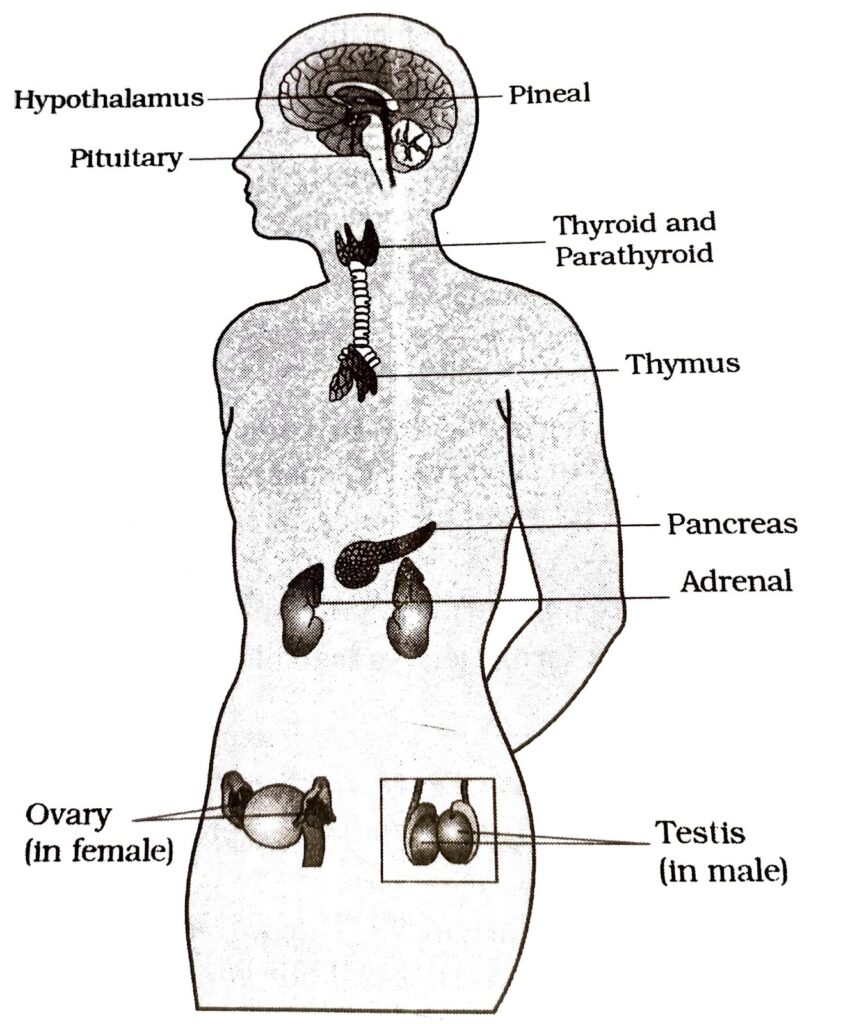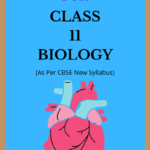NCERT Class 11 Biology Chapter 22 Chemical Coordination and Integration Solutions to each chapter is provided in the list so that you can easily browse through different chapters NCERT Class 11 Biology Chapter 22 Chemical Coordination and Integration and select need one. NCERT Class 11 Biology Chapter 22 Chemical Coordination and Integration Question Answers Download PDF. NCERT Biology Class 11 Solutions.
NCERT Class 11 Biology Chapter 22 Chemical Coordination and Integration
Also, you can read the NCERT book online in these sections Solutions by Expert Teachers as per Central Board of Secondary Education (CBSE) Book guidelines. CBSE Class 11 Biology Solutions are part of All Subject Solutions. Here we have given NCERT Class 11 Biology Chapter 22 Chemical Coordination and Integration Notes, NCERT Class 11 Biology Textbook for All Chapters, You can practice these here.
Chemical Coordination and Integration
Chapter: 22
BIOLOGY
TEXTUAL QUESTIONS ANSWERS
Q.1. Define the following:
(a) Exocrine gland.
Ans. Exocrine gland is gland that secretes its hormones into the target organ by means of duct or on the surface e.g. sweat glands, sebaceous glands, salivary glands, and intestinal glands.
(b) Endocrine gland.
Ans. Endocrine gland is gland that secretes its hormones into blood or lymph for reaching the target organ and gland is not connected to target organ by any duct [ductless gland] eg thyroid glands.
(c) Hormone.
Ans. HORMONES are non-nutrient chemicals which act as intercellular messengers and are produced in trace amounts.
Q.2. Diagrammatically indicate the location of the various endocrine glands in our body.
Ans.

Q.3. List the hormones secreted by the following:
(a) Hypothalamus.
Ans. Hormones produced by hypothalamus are two types:
(i) Releasing hormones: stimulate secretion of pituitary hormones e.g. Gonadotrophin releasing hormone (GnRH), Adrenocorticotropic releasing hormone [ACTH], Thyrotropin Releasing Hormone [TRH].
(ii) Inhibiting hormones: inhibit secretions of pituitary hormones e.g. somatostatin inhibits the release of growth hormone from the pituitary.
(b) Pituitary.
Ans. Pituitary:
(i) Anterior pituitary produces growth hormone (GH), prolactin (PRL), thyroid stimulating hormone (TSH), adrenocorticotropic hormone (ACTH), luteinizing hormone (LH) and follicle stimulating hormone (FSH).
(ii) Posterior pituitary stores and releases two hormones – oxytocin and vasopressin.
(c) Thyroid.
Ans. Thyroid: tetraiodothyronine / thyroxine (T4), triiodothyronine (T3); thyrocalcitonin (TCT).
(d) Parathyroid.
Ans. Parathyroid: parathyroid hormone (PTH).
(e) Adrenal.
Ans. Adrenal:
Adrenal medulla secretes hormones called catecholamines: adrenaline or epinephrine and noradrenaline or norepinephrine
Adrenal cortex is divided into three layers:
(i) Zona reticularis (inner layer) secrets sex hormones called androgens.
(ii) Zona fasciculata (middle layer) secretes glucocorticoids. Cortisol is the main glucocorticoid.
(iii) Zona glomerulosa (outer layer) secretes mineralocorticoids. Aldosterone is the main mineralocorticoid l.
(f) Pancreas.
Ans. Pancreas: The a-cells secrete glucagon and β-cells secrete insulin.
(g) Testis.
Ans. Testis: produce androgens mainly testosterone.
(h) Ovary.
Ans. Ovary: produces two steroid hormones called estrogen and progesterone.
(i) Thymus.
Ans. Thymus: thymosins.
(j) Atrium.
Ans. Atrium: atrial natriuretic factor (ANF).
(k) Kidney.
Ans. Kidney: erythropoietin.
(l) G-I Tract.
Ans. G-I Tract: secrete four major peptide hormones: gastrin, secretin, cholecystokinin (CCK) and gastric inhibitory peptide (GIP).
Q.4. Fill in the blanks:
| Hormones | Target Gland |
| Hypothalamic hormones | ____________ |
| Thyrotropin (TSH) | ____________ |
| ACTH | ____________ |
| LH, FSH | ____________ |
| MSH | ____________ |
Ans. (i) — pituitary gland.
(ii) – thyroid.
(iii) – adrenal cortex.
(iv) — gonads.
(v) melanocytes.
Q.5. Write short notes on the functions of the following hormones:
(a) Parathyroid hormone (PTH).
Ans. Parathyroid hormone (PTH) increases the Ca²⁺ levels in blood. PTH acts on bones and stimulates bone resorption / demineralisation. PTH stimulates reabsorption of calcium by renal tubules and increase calcium absorption from the digested food.
(b) Thyroid hormones.
Ans. Thyroid hormones:
(i) Thyroid hormones, tetraiodothyronine / thyroxine (T4) triiodothyronine (T3) regulate the basal metabolic rate, development and maturation of CNS. These hormones support red blood cell formation. Thyroid hormones control the metabolism of carbohydrates, proteins and fats.
Thyrocalcitonin (TCT) regulates the blood calcium levels by decreasing it.
(c) Thymosins.
Ans. Thymosins: Thymosins cause the differentiation of T-lymphocytes, which provide cell-mediated immunity. Thymosins also promote production of antibodies to provide humoral immunity.
(d) Androgens.
Ans. Androgens stimulate the growth of axial hair, pubic hair and facial hair during puberty.
(e) Estrogens.
Ans. Estrogens stimulates development of growing ovarian follicles, growth of female secondary sex organs, female secondary sex characters (e.g., high pitch of voice, etc.) and mammary gland development. Estrogens regulate female sexual behaviour
(f) Insulin and Glucagon.
Ans. Insulin and Glucagon Glucagon is a hyperglycemic hormone because:
1. Glucagon stimulates glycogenolysis and gluconeogenesis which contributes to increased blood sugar (hyperglycemia).
2. Glucagon reduces the cellular glucose uptake and utilisation.
Insulin is a hypoglycemic hormone because:
1. Insulin also stimulates conversion of glucose to glycogen (glycogenesis).
2. Insulin enhances cellular glucose uptake and utilisation resulting in decrease blood glucose levels (hypoglycemia).
Q.6. Give example of:
(a) Hyperglycemic hormone and hypoglycemic hormone.
Ans. Glucagon and insulin.
(b) Hypercalcemic hormone.
Ans. Parathyroid hormone.
(c) Gonadotropic hormone.
Ans. FSH & LH.
(d) Progestational hormones.
Ans. Progesterone.
(e) Blood pressure lowering hormone.
Ans. ANF.
(f) Androgens and estrogens.
Ans. Testosterone and estradiol.
Q.7. Which hormonal deficiency is responsible for the following:
(a) Diabetes mellitus.
Ans. Insulin deficiency or resistance leads to diabetes mellitus.
(b) Goitre.
Ans. Deficiency of iodine in our diet results in hypothyroidism and enlargement of the thyroid gland, commonly called goitre.
(c) Cretinism.
Ans. Hypothyroidism in pregnancy or childhood causes cretinism: — stunted growth, mental retardation, low intelligence quotient, abnormal skin, deaf-mutism, etc.
Q.8. Briefly mention the mechanism of action of FSH.
Ans. Hormones produce their effects on target tissues by binding to specific proteins called hormone receptors located in the target tissues only. Binding of a hormone to its receptor leads to the formation of a hormone – receptor complex. Each receptor is specific to one hormone only and hence receptors are specific. Hormone-Receptor complex formation leads to biochemical changes in the target tissue.

Hi! my Name is Parimal Roy. I have completed my Bachelor’s degree in Philosophy (B.A.) from Silapathar General College. Currently, I am working as an HR Manager at Dev Library. It is a website that provides study materials for students from Class 3 to 12, including SCERT and NCERT notes. It also offers resources for BA, B.Com, B.Sc, and Computer Science, along with postgraduate notes. Besides study materials, the website has novels, eBooks, health and finance articles, biographies, quotes, and more.




